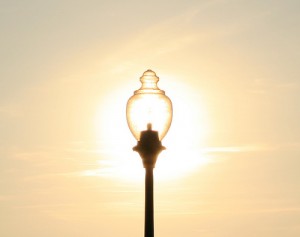The days are getting shorter. For those of us who toil away in office cubicles, the darker days of winter are especially trying. Heck, we can barely get any light as it is. Once we're going to work before the sun rises and staying until long after the early dusk, we're lucky if we see any sunlight at all. This isn't just a bummer for wage slaves. Since natural light has been shown to boost worker productivity, it behooves employers to find ways to get some sunlight - or a close approximation - into their offices. Preferably while not shelling out tons of cash no one has.
Here a few great ways to get started.
1. Take advantage of the windows you already have.

Lower cubicle walls - or do away with them altogether - and embrace an open plan office design to maximize the amount of natural light. Place workers' desks closer to the windows so that they get as much of that healing (and motivating) vitamin D as possible.
2. Place lamps at irregular intervals.

It might sound strange, but irregular lighting is actually better for your eyes than a bright, evenly-lit room.
"If we are working in a space with one uniform type of lighting, which a lot of us do ... that can cause a lot of distraction to our eyes," says Doreen Le May Madden, a certified lighting consultant. Our eyes seek out the brightest area in the room, she says. If there's no single brightest spot, our eyes shift around, looking for light and becoming strained and fatigued.
3. Buy full-spectrum light bulbs - but get a deal.

Full-spectrum bulbs are significantly more expensive that fluorescents, but you can cut costs by ordering in bulk or from wholesalers. You can also encourage workers to bring in their own lamps from home, further cutting down on the expense.
4. Skip the overheads.

It seems like overhead lighting would be the best way to brighten up a room, but trust us: your workers will be way happier if you turn off those flickering, yellow-tinged light panels and double up on indirect lighting. It'll ease eye strain, and make the office more cheerful to boot.
5. Swap out fluorescents for CMH lighting.

Ceramic metal halide lighting has a shorter shelf-life than fluorescent bulbs, but gives a truer color. They're also energy efficient, which is great for the planet - and your wallet.





